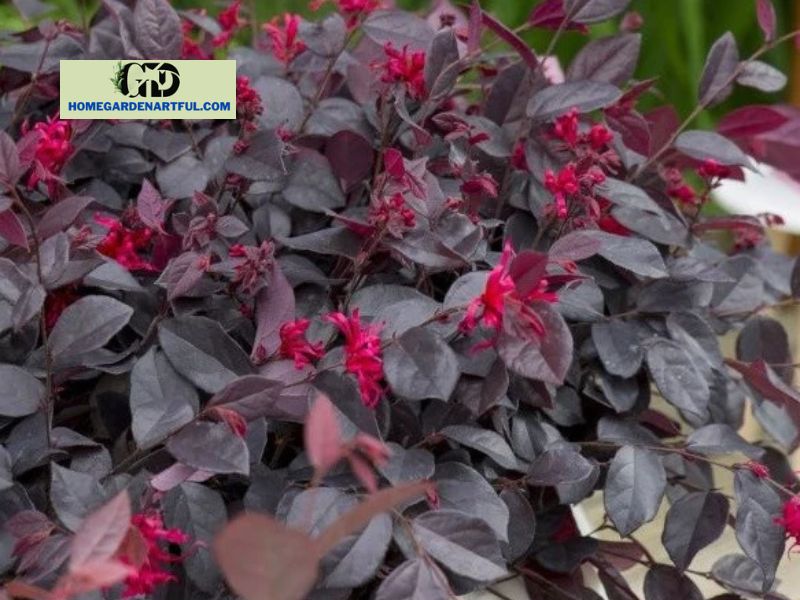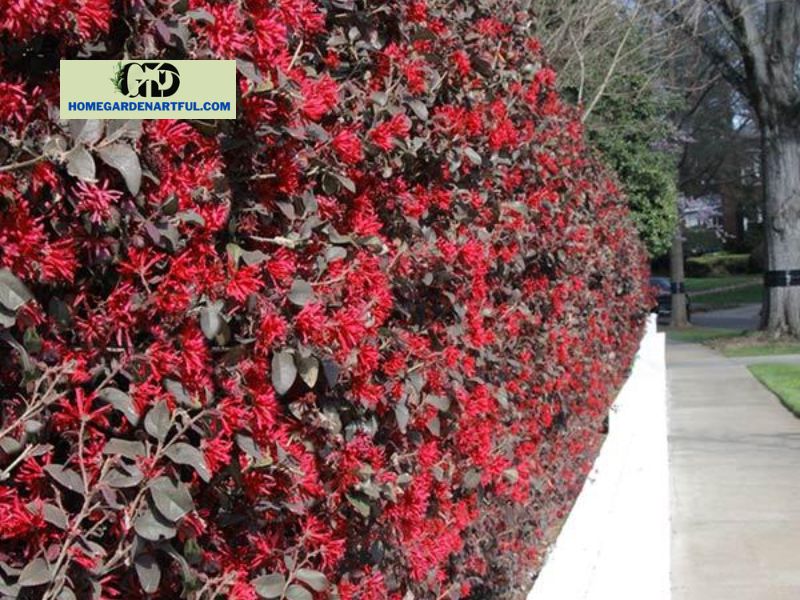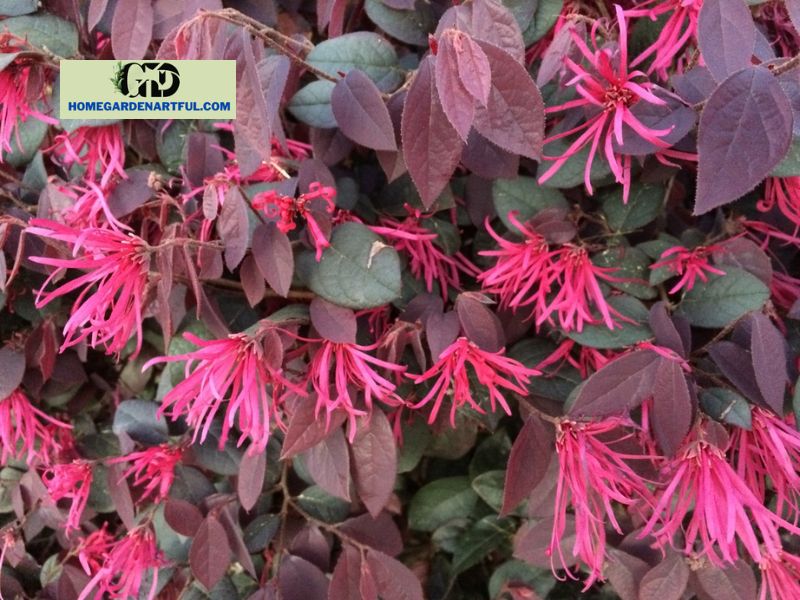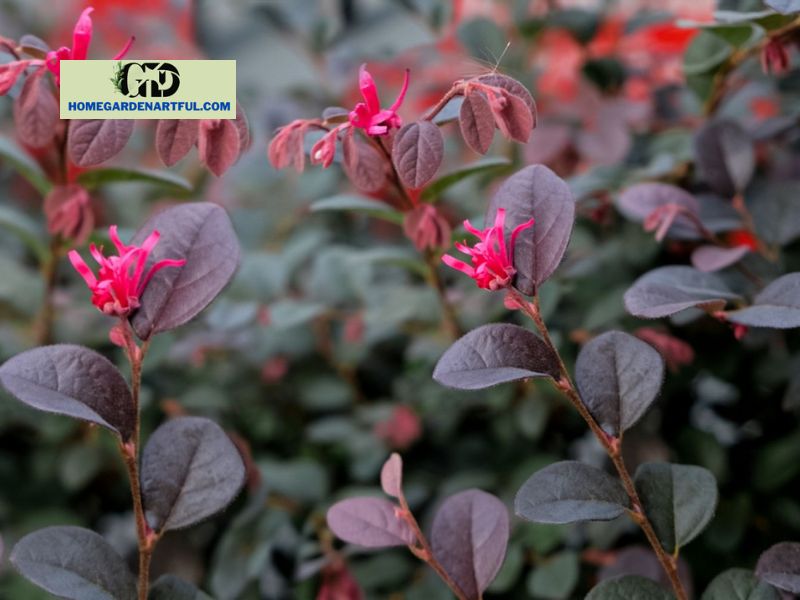Ever Red Loropetalum Shrub is a simple plant to cultivate. You can almost plant them and forget about them. But you won’t since these bushes, also known as Chinese fringe-flowers, have gorgeous and versatile blossoms. Discover at homegardenartful.com!
Ever Red Loropetalum Shrub Care

Loropetalum thrives in small groupings, such as specimen plants, hedges, borders, or screens. They are six to fifteen feet tall and wide, with dwarf, medium-sized, and tall varieties that weep or grow upright. Taller plants grow faster than shorter plants. Most thrive in USDA Zones 7–10. The roots of Loropetalum are not known to be invasive.
Light
Loropetalum flourishes in full light that has been filtered, all-day sun, or chilly morning sun with afternoon shade. They require at least 4 hours of direct sunlight per day.
Soil
Loropetalum requires rich, loamy, loose soil that is slightly acidic to neutral (4.0 to 7.0 pH) and drains swiftly. In clay or deep soils, work bagged topsoil or planting soil into a 50/50 mix of native soil and additions. Mix compost, topsoil, or peat moss into sandy soil to improve it.
Water
Thoroughly and deeply water newly planted Loropetalum. Then, if there isn’t enough rain, water regularly to maintain the soil moist. Established plants are extremely drought-resistant. Overwatering should be avoided since they cannot tolerate moist soil or persistently wet roots.
Humidity and temperature
Loropetalum can withstand temperatures as low as 0°F. Mulching in the winter helps to keep moisture in the soil. Keep plants safe against strong winds and harsh winter conditions. Loropetalum thrives in moderate humidity conditions. To give moisture to Loropetalum in an arid region, use a spray bottle.
Fertilizer
Loropetalum should be mulched with between two and four inches of pine straw, shredded bark, or seasoned wood chips. Keep the mulch away from the plants and refill it as needed. Feed Loropetalum with an all-purpose slow-release fertilizer as well as shrub fertilizer in late spring and mid-summer. Follow the label’s instructions and thoroughly water.
Pruning
Loropetalum after the petals fade in the spring to manage their size or shape. Remove any branches that are damaged, dead, or unhealthy. Loropetalum is a low-maintenance plant that can withstand extensive pruning if used as Bonsai, topiaries, or around foundations. Because Loropetalum grows on old wood, prune after flowering, which is normally from summer to early fall.
Loropetalum propagation

Loropetalum propagates easily from softwood cuttings in the spring and summer. Make sure your plant is not patented before propagating it. Propagation of patented plants is prohibited. If your plant is patent-protected, check the tag, label, or container. Plants that have been patented will have a registered trademark, a trademark, or a patent number next to their name. Loropetalum can be propagated in the following ways:
- Take a six-inch slice of soft, woody growth with pruning shears or a sharp knife.
- Remove all except at least 2 sets of top leaves.
- After dipping the ends in the rooting hormone, place them in a 50/50 mix of perlite and peat.
- Cover them in clear plastic bags to create a greenhouse effect, but don’t let the plastic touch them. Maintain a wet soil.
- Roots should appear in four to six weeks and can be transplanted the following growing season.
Loropetalum Potting and Repotting
Report Ever Red Loropetalum Shrub while pruning to ensure that it has fewer branches to maintain its root system. Dig up the Loropetalum plant with care, leaving a large radius around the root system. When transplanting Loropetalum into a container, select a dwarf or slow-growing type. Use pots with drainage holes and high-quality potting soil.
Overwintering
Ever Red Loropetalum Shrub is an evergreen perennial with falling leaves in cooler areas. If temperatures fall below 0°F, protect their roots with mulch as well as cover them with burlap or shrub wraps. Keep plants safe from severe winter winds. Loropetalum requires moisture throughout the winter, however, watering can be reduced if the plant does not entirely dry out.
Common Plant Pests and Diseases

Ever Red Loropetalum Shrub is not bothered by pests or illnesses. Spray horticultural oil or insecticidal soap on persistent infestations of spider mites or aphids to kill them. Chemical insecticides should be avoided since they destroy helpful insects that help manage aphids. Keep plants healthy by fertilizing and watering them correctly. Remove infested branches by pruning, using double-sided, sticky tape traps, or spraying with horticultural oil.
Fungal blights as well as powdery mildew are two diseases that affect Loropetalum. Anthracnose is a fungal blight that produces yellowing, withering, and premature leaf drop. Loropetalum is also susceptible to bacterial gall. Although there is no treatment, fungicides may prevent galls from spreading. Avoid overcrowding while planting and watering from above to keep Loropetalum healthy. Furthermore, always utilize clean pruning shears and shears.
How to Make Loropetalum Bloom
Ever Red Loropetalum Shrub may not blossom for a variety of reasons. One of the reasons Loropetalum is not blooming is a lack of sunlight. The overhead shade may hinder Loropetalum from blossoming if grown under trees. Furthermore, because Loropetalum flowers on old wood, pruning it at the incorrect time can prevent it from blossoming. Pruning should be done in the summer or early fall to avoid removing the blossoms for the following year. Loropetalum does not need deadheading, however removing wasted blooms is one way to keep plants healthy.


